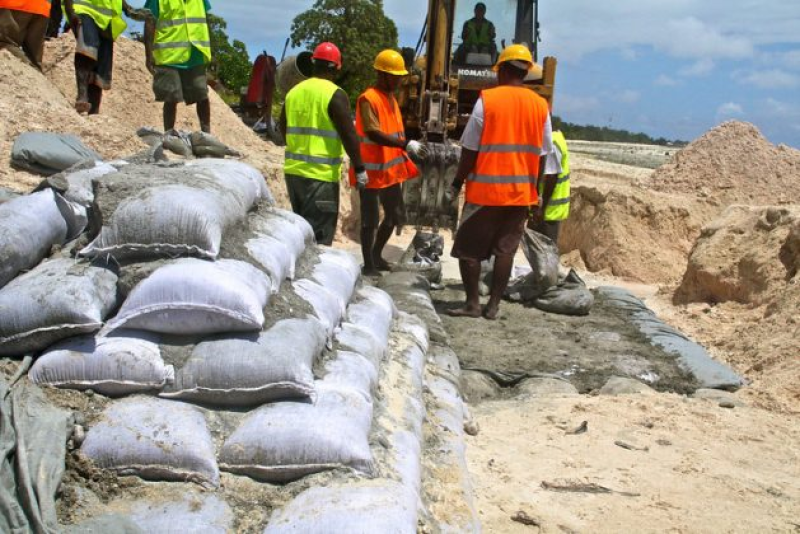- Southeast Asia Floods Kill Over 250, Thousands Displaced |
- Trump Vows to Halt Migration From ‘Third World’ Nations |
- Journos should strengthen themselves to secure rights: Fakhrul |
- Hong Kong’s deadliest fire in a century: How it spread |
- Khaleda ‘moved to Evercare CCU |
Ocean Heat, Rising Seas Threaten South-West Pacific Life

The South-West Pacific experienced unprecedented warming in 2024, according to a World Meteorological Organization (WMO) report released today (June 5) — threatening islands in a region where half the population lives close to the coast.
The State of the Climate in the South-West Pacific 2024 report said that sea-surface temperatures were the highest on record, and ocean heat content was at near-record levels in 2024. Nearly 40 million km² (15.4 million square miles) — an area almost the size of the Asian continent — was affected by marine heatwaves.
On land, extreme heat and rainfall caused deadly and devastating impacts. A record-breaking streak of tropical cyclones hit the Philippines, while the last remaining tropical glacier in Indonesia’s New Guinea moved closer to extinction, the WMO said in a statement.
“2024 was the warmest year on record in the South-West Pacific region. Ocean heat and acidification combined to inflict long-lasting damage to marine ecosystems and economies. Sea-level rise is an existential threat to entire island nations. It is increasingly evident that we are fast running out of time to turn the tide,” said WMO Secretary-General Prof. Celeste Saulo.
The report was released to coincide with the Global Platform on Disaster Risk Reduction 2025 in Geneva and ahead of the 2025 UN Ocean Conference.
However, the report also highlighted how strengthened early warning systems and anticipatory action in the Philippines enabled communities to prepare and respond to the back-to-back typhoons in 2024. This helped to protect lives and livelihoods and ensured dignified, timely support for vulnerable communities.
During a press briefing on the report, Catherine Jones, Disaster Resilience Officer from the Food and Agriculture Organization (FAO), shared how “anticipatory action protocols” assisted a community in the Bicol Region on an island called Catanduanes. On November 13, 2024, the fifth cyclone in the region intensified into a Category 5 super typhoon, and a warning was issued that it would make landfall on the 16th. The organisation supported 2,800 households with multi-purpose cash to protect their livelihoods, and the early warning system also enabled these households to evacuate and secure their boats.
“When we went back to speak with various fisherfolk who received the support, they said to us that because they received the warnings before the event, they were able to get back onto the water one week after the sediment and the ocean had settled; they were able to jump straight back into their livelihood and provide for their families.”
The WMO says that this example exemplifies the value of the Early Warnings for All (EW4All) initiative, which is one of its top strategic priorities — even though the report says 50,000 Pacific Islanders face the risk of displacement due to climate change.
Key highlights of the report include:
-
2024 was the warmest year on record in the South-West Pacific region, at approximately 0.48°C above the 1991–2020 average, linked to the ongoing 2023/2024 El Niño event.
-
The southern coast of Australia, northern New Zealand, and many Pacific Islands experienced precipitation deficits.
-
Malaysia, Indonesia, the northern Philippines, northern Australia, eastern Papua New Guinea, the Solomon Islands, and southern New Zealand recorded above-average rainfall.
-
Extreme rainfall and flooding caused deadly and destructive impacts across the region, severely affecting communities, infrastructure, and economies.
-
The Philippines endured an unprecedented tropical cyclone season late in 2024, with 12 storms between September and November — more than double the average. Over 13 million people were affected across 17 of the country’s 18 regions, with more than 1.4 million displaced.
-
Indonesia’s glacier ice loss continued rapidly in 2024, with the western part of New Guinea losing 30–50% of its total ice area since 2022. Total ice loss is expected by 2026 or soon after.
-
Most of the South-West Pacific’s ocean area experienced strong to extreme marine heatwaves in 2024, affecting nearly 40 million km² — the highest since records began in 1993.
Sea Level Rise in the Pacific Islands
Communities on the Pacific Islands face tough decisions about staying in high-risk areas or relocating to safeguard their futures.
“Villagers are running out of adaptation options. Building seawalls, planting mangroves, and improving drainage systems are no longer viable,” the report says, citing an example from Fiji’s government, which has offered relocation support to islanders. However, many choose to stay due to their deep connection to “vanua” — a term meaning “land,” reflecting the cultural and spiritual bond with ancestral land.
During a press briefing, Juhi Bansal of the UNFCCC described daily life on Sarawak Island:
“Since 2000, rising sea levels have caused severe coastal erosion, flooding, and saltwater intrusion. Crops have failed, homes have been submerged, and sea walls repeatedly destroyed during extreme flooding. Boats are now used to navigate between homes, and villagers build planks between them and dock boats at their doors during high tide.”
She added: “These communities have tried every adaptation strategy — sea walls, mangrove restoration, crop relocation — but they are all temporary. With each king tide, Sira Island inches closer to becoming uninhabitable.”
Bansal said the report comes at a critical time as countries prepare their next generation of Nationally Determined Contributions (NDC 3.0) and National Adaptation Plans (NAPs).
“The dual task of increasing climate ambition while ensuring development goals are met is complex but achievable — especially through strong partnerships, committed leadership, and scaled-up financial support. These case studies underscore the need to fund locally led climate action and ensure that when relocation is required, it is done with dignity, cultural sensitivity, and the support of affected communities.”

